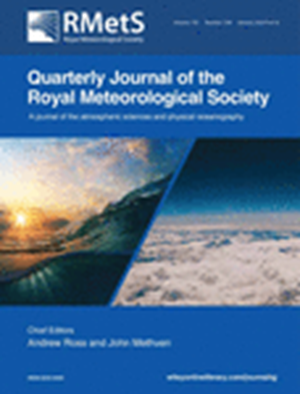Post‐processing output from ensembles with and without parametrised convection, to create accurate, blended, high‐fidelity rainfall forecasts
IF 2.9
3区 地球科学
Q2 METEOROLOGY & ATMOSPHERIC SCIENCES
引用次数: 0
Abstract
Flash flooding is a significant societal problem, but related precipitation forecasts are often poor. To address, one can try to use output from convection‐parametrising (global) ensembles, post‐processed to forecast at point‐scale, or convection‐resolving limited area ensembles. The new methodology described here combines both. We apply “ecPoint‐rainfall” post‐processing to the ECMWF global ensemble. Alongside we use 2.2 km COSMO LAM ensemble output (centred on Italy), and also post‐process that, using a scale‐selective neighbourhood approach to compensate for insufficient members and to preserve consistently forecast local details. The two resulting scale‐compatible components then undergo lead‐time‐weighted blending, to create the final probabilistic 6 h rainfall forecasts. Product creation for forecasters, in this way, constituted the “Italy Flash Flood use case” within the EU‐funded MISTRAL project; real‐time delivery of open access products is ongoing. One year of verification shows that, of the five components (2 raw, 2 post‐processed and blended), ecPoint is the most skilful. The post‐processed COSMO ensemble adds most value to summer convective events in the evening, when the global model has an underprediction bias. In two typical heavy rainfall case studies we observed underestimation of the largest point totals in the raw ECMWF ensemble, and overestimation in the raw COSMO ensemble. However, ecPoint elevated the ECMWF maxima and highlighted best the most affected areas and merged products seemed to be the most skilful of all. Even though our LAM post‐processing does not include (or arguably need) bias‐correction, this study still provides a unique blueprint for successfully combining ensemble rainfall forecasts from global and LAM systems around the world. It also has important implications for forecast products as global ensembles move ever closer to having convection‐permitting resolution.对有参数化对流和无参数化对流的集合输出进行后处理,以创建准确、混合、高保真的降雨预报
山洪暴发是一个重大的社会问题,但相关的降水预报往往很差。为了解决这个问题,我们可以尝试使用对流参数上升(全球)集合的输出结果,经过后处理后再进行点尺度预报,或者使用对流解析有限区域集合的输出结果。这里介绍的新方法将两者结合起来。我们对 ECMWF 全球集合进行 "ecPoint-rainfall "后处理。同时,我们使用 2.2 千米 COSMO LAM 集合输出(以意大利为中心),并对其进行后处理,使用尺度选择邻域方法来弥补成员的不足,并保留持续预报的局部细节。然后,将这两个规模兼容的部分进行前置时间加权混合,以生成最终的 6 小时概率降雨预报。在欧盟资助的 MISTRAL 项目中,以这种方式为预报员创建产品构成了 "意大利山洪暴发用例";目前正在实时提供开放式产品。一年的验证结果表明,在五个组件(2 个原始组件、2 个后处理组件和混合组件)中,ecPoint 是最娴熟的组件。经过后处理的 COSMO 集合对夏季傍晚的对流事件最有价值,而此时全球模式的预测偏差不足。在两个典型的暴雨案例研究中,我们观察到原始的 ECMWF 集合低估了最大的点总量,而原始的 COSMO 集合则高估了最大的点总量。然而,ecPoint 提高了 ECMWF 的最大值,最能突出受影响最严重的地区,而合并产品似乎是所有产品中最娴熟的。尽管我们的 LAM 后处理不包括(或可以说不需要)偏差校正,但这项研究仍为成功合并全球和 LAM 系统的集合降雨预报提供了独特的蓝图。随着全球集合越来越接近对流允许的分辨率,它对预报产品也有重要影响。
本文章由计算机程序翻译,如有差异,请以英文原文为准。
求助全文
约1分钟内获得全文
求助全文
来源期刊
CiteScore
16.80
自引率
4.50%
发文量
163
审稿时长
3-8 weeks
期刊介绍:
The Quarterly Journal of the Royal Meteorological Society is a journal published by the Royal Meteorological Society. It aims to communicate and document new research in the atmospheric sciences and related fields. The journal is considered one of the leading publications in meteorology worldwide. It accepts articles, comprehensive review articles, and comments on published papers. It is published eight times a year, with additional special issues.
The Quarterly Journal has a wide readership of scientists in the atmospheric and related fields. It is indexed and abstracted in various databases, including Advanced Polymers Abstracts, Agricultural Engineering Abstracts, CAB Abstracts, CABDirect, COMPENDEX, CSA Civil Engineering Abstracts, Earthquake Engineering Abstracts, Engineered Materials Abstracts, Science Citation Index, SCOPUS, Web of Science, and more.

 求助内容:
求助内容: 应助结果提醒方式:
应助结果提醒方式:


